Gateway NV52 (AMD) - OS Benchmarks
The final aspect of operating system performance we want to look at involves common OS tasks. We measure how long it takes to perform the routine operations of booting, shutting down, hibernating, resuming, suspending, and waking your computer using the four test operating systems. Unlike other test results, there was a huge degree of variability in some of the tests. We ran each test at least five times, and we took the best result - the reason being that some of the results were completely out of line with the average result, so including one or two results where the system took four times as long it didn't seem logical. Ubuntu and Windows 7 didn't show as much variation as XP and Vista, particularly in the sleep/wake testing, but the hibernate/resume test once again varies quite a bit between test runs.
The variability remained even after following a relatively straightforward test procedure. First we booted each laptop using the test OS (timing how long it took). Then we let the system stabilize for at least 15 minutes, with no extra applications running and the system sitting idle at the desktop. Finally, we performed one of the other tests - shut down, hibernate/resume, or sleep/wake. Obviously, you can't test resume time without first hibernating, and you can't test wake time without first putting the system to sleep, but otherwise we made sure to shut down the system between test runs.
We also need to mention that Windows XP has an inherent advantage in the hibernate/resume testing because we are using a 32-bit OS instead of a 64-bit OS. That means the system doesn't make use of all 4GB of memory, and the hibernation file is 3GB. Writing 3GB of data will obviously be easier than writing 4GB of data, especially when you're dealing with a 5400 RPM laptop hard drive.
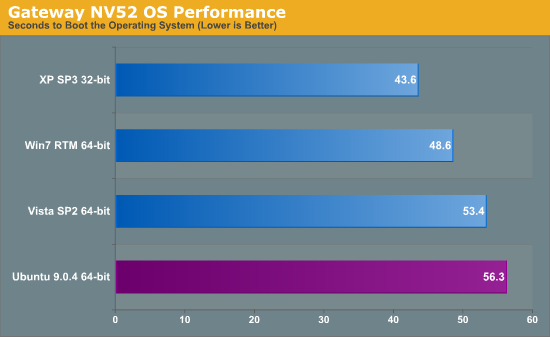
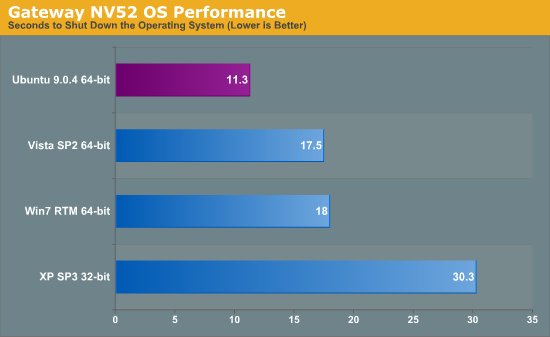
The results are rather scattered this time, with certain functions favoring one OS and others looking better on a different OS. Boot times favor Windows XP, followed by Windows 7 which takes 11% longer. Vista trails Windows 7 by 10%, and Ubuntu brings up the rear at 5% longer than Vista. Shutdown times are a different matter, where Ubuntu takes the lead. Vista and Windows 7 are essentially tied, taking 55-60% longer to shut down than Ubuntu. Windows XP brings up the rear this time, at over 2.5 times as long as Ubuntu, although we have to say that this appears to be a driver issue as the result for the NV58 is radically different. When you shut down Windows XP on the NV52, there's a delay of about 15 seconds where there is no apparent activity, after which the hard drive activity light begins blinking. It would seem that without that handicap, Windows XP would be roughly the same as Vista and Windows 7.
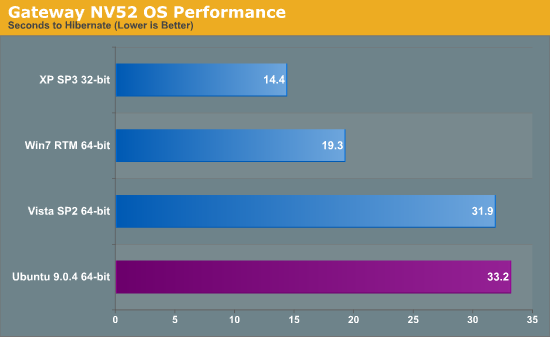
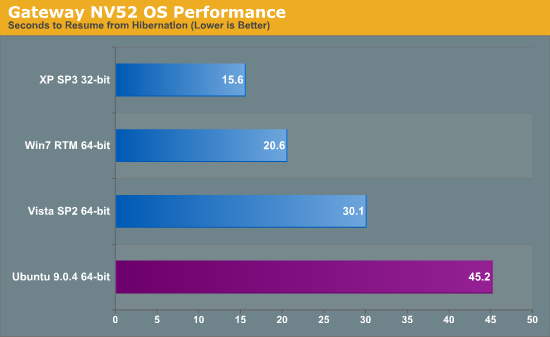
As already stated, Windows XP 32-bit has an advantage for the hibernate/resume testing because it doesn't have as much addressable RAM. It ends up walking away with the hibernate/resume performance crown, followed by Windows 7. That said, the time to hibernate in Windows 7 is 34% longer than Windows XP and resume time is 32% longer; Win7 has 33% more memory, so a 32-bit version of Windows 7 ought to be as fast as Windows XP (or a 64-bit XP as slow as Win7). The gap between Windows 7 and Windows Vista is extremely large for hibernation time, with Vista taking 65% longer to hibernate and 46% longer to resume. Ubuntu is almost tied with Vista on the hibernation time, but it takes 50% longer to resume - about twice as long as Win7 - making it by far the slowest OS for this particular test.
We need to take a moment to discuss boot times and resume times, however, as there's more going on than meets the eye. When booting or resuming a system, the computer needs to perform a Power On Self Test (POST). That takes around nine seconds on these Gateway systems, and once that's complete the boot loader is activated which then loads the OS. Ubuntu uses GRUB and that appears to add an extra ~10 seconds relative to Windows. Without that time penalty, Ubuntu would be far more competitive in boot time (about equal to Win7), although it would still be in last place in the resume test. There are also laptops that have a fast boot feature so that they don't perform a lengthy POST, which can shave another 6 or 7 seconds off the boot/resume times. This is definitely a feature we would like to see implemented on more systems going forward, particularly laptops where users routinely boot or resume several times per day.
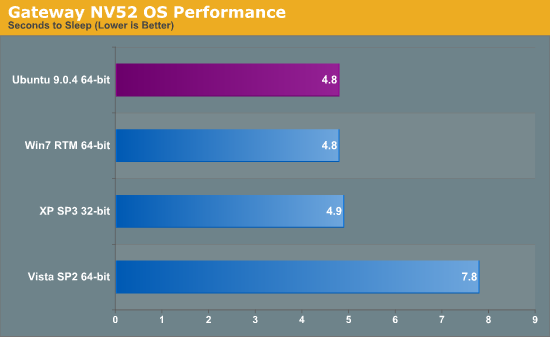
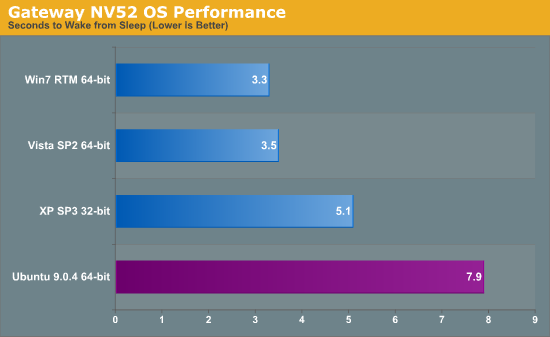
Wrapping up the OS performance analysis, the sleep/wake times were highly variable on the Windows XP and Vista operating systems. This is especially true if you put the system to sleep right after waking it up, booting, resuming, or any other complex task; in those cases, it might take over a minute to go back to sleep. Ouch! It may also take over 20 seconds for Windows to go to sleep if you have a bunch of applications open - that's about six times as long to put your laptop to sleep, which can be very annoying if you just want to pack up and go. You might think that you can just put your system to sleep and throw it in its bag and walk off, but sometimes a glitch will prevent a laptop from going to sleep so we like to make sure our laptops actually shut off before putting them in an enclosed space. We have heard of a few instances where a laptop has apparently overheated because it didn't go to sleep and a user put it in a laptop bag, resulting in a dead system. That's some food for thought anyway. Ubuntu and Windows 7 did a lot better, with the worst-case result being around twice as long as the best time.
Sleep times are a tie between Ubuntu, XP, and 7 at just under 5 seconds. Vista took noticeably longer even in our best-case result, trailing XP by 59%. Wake times mix things up quite a bit and show a lot less variation between runs, with Ubuntu falling to dead last and Vista and 7 essentially tied at ~3.5 seconds. XP takes 46% longer than Vista to wake and Ubuntu is 55% longer than XP (over twice as long as Win7). Again, though, variability in sleep times makes us prefer Windows 7 and Ubuntu followed by XP, with Vista being the worst at consistently going to sleep without a large delay.










106 Comments
View All Comments
JarredWalton - Tuesday, September 22, 2009 - link
I'll look into powertop in a while. The issues with Windows really have a lot more to do with users than with the platform as a whole. My work PC has been running without any problems and without reinstalling the OS for over three years. My gaming system is in a similar state, and both have been through a few hardware upgrades, plus various driver and software installations.I don't run any "internet security suite" - be it McAfee, Norton, AVG, or anyone else. No AV, not even anti-malware (though I have scanned with Spybot S&D, Ad-Aware, and HiJackThis on occasion just to make sure). Why am I problem free? Because I know what I'm doing.
I think the same could be said of Linux users: they're mostly problem free because they know what they're doing, and they could be problem free in Windows if they wanted to put in a small amount of effort.
Put your average user in front of a Ubuntu installation -- or any Linux installation -- and they're going to be lost as soon as they want to do more than run email, OpenOffice, and surf the Internet. "But that's all you need!" Exactly: all you need and all you want are not the same. Windows makes it perhaps too easy for people that haven't got a clue to install programs and screw things up. LOL
Gamingphreek - Wednesday, September 23, 2009 - link
Honestly, all the configuration I suggested takes a few minutes at most. There is no compiling from source and no generating makefiles.As someone said earlier, Linux and Windows have different philosophies in terms of setup. Linux is an OS that depends on customization, at least SOME time needs to be put in configuring it.
Running powertop and writing a bash script takes a mere 5 minutes and can save >30 minutes of battery life in some cases. Enabling laptop mode is literally as simple as opening a file and changing the value from 0 to 1.
Updating the kernel, mesa, and graphics is literally 6 (2 for each -- 1 to add the repository and 1 to add the key) commands long and takes <5 minutes.
I understand this isn't an article on Linux, but these are not in depth tweaks and are things that anyone running Linux on a laptop will typically do.
Finally, you state that an average user would be lost in Linux. Honestly this is Anandtech - a very well known and reputable Tech based website. "Average users" typically do not venture here. Should you guys stop talking about Processor Architecture since people wont know what it means?
strikeback03 - Wednesday, September 23, 2009 - link
My father needed to move suddenly due to a job change, so I hooked him up with a computer I scavenged out of the trash at work. It had a XP license key on it, but thanks to their wonderful restrictions on what what disc can install what version I had no working installer for that key. So I threw Ubuntu on there, which does indeed do everything he needs (allow him to play with his investments and watch Hulu). He called last weekend asking where to find a driver for a printer that was not included by default, as the solution involved several lines of code he decided to just wait until I can walk him through setting up Remote Desktop and do it from here.Mattus27 - Monday, September 21, 2009 - link
I can't believe you tested using live dynamic websites, instead of just downloading a page and all its resources and running the test from disk. The drawbacks of that should have been fairly obvious.JarredWalton - Monday, September 21, 2009 - link
The problem is, there is a ton of JavaScript involved with any current website, and getting all of the content for an offline version isn't quite that simple. Go try it: download everything for www.AnandTech.com to your PC and then look at that file and compare it to how the site actually looks. Try that with Facebook, YouTube, Yahoo, MSN, CNN, HardOCP, FiringSquad, SlashDot, TechReport, etc. and you will find they all need tweaking to look anything approaching correct. (Well, maybe not every single one of them, but most will still end up with JavaScript files that load content from dynamic web servers.)Anyway, I wanted to test with "real" content and not some bogus artificial test that doesn't have anything to do with what real Internet sites are like (i.e. some of the MobileMark stuff has very questionable testing procedures). I wanted something I had control of that would still tax PCs like a real website. I've got some downloaded sites and I've been going through the HTML and modifying it to hopefully create a "static" page that I can host on our server and still have it work more or less correctly. That of course means another batch of testing, but so far it's looking good.
I debated scrapping the current article, but figured some would enjoy the read and the joys of testing multiple different OSes. Besides, this way I can get feedback on what other tests you might like to see.
gstrickler - Friday, September 25, 2009 - link
How about setting up a local caching web proxy and having all the machines connect via the proxy? It won't completely eliminate the variances of internet routing/throughput and connecting to live sites, but it should minimize them.As for Wi-Fi (and interference from your 2.4GHz phone), leave the Wi-Fi enabled and connected, but go ahead and connect the machines using Ethernet. The difference is drain of a modern Wi-Fi transceiver when transmitting/receiving vs "idle" is fairly small, so simply having it on and connected to the Wi-Fi access point (which will occasionally "talk" to each connected client") should be sufficient from a power draw standpoint while using Ethernet for the active network connection will be more reliable and won't be subject to the interference. You can put the Wi-Fi on a subnet that does not route to your proxy/firewall and/or give it no default gateway, which will ensure that all the real traffic in on Ethernet. You could add in an occasional Ping from each client to the WAP to ensure that the Wi-Fi card/connection stays active.
andrewaggb - Tuesday, September 22, 2009 - link
Well I certainly agree that testing dynamic websites at different times is not the way to go.I can also understand what you are saying about trying to download a site and all the related resources, I've tried in the past and the browser method doesn't work.
You'll probably need an external tool to download the site and all it's resources. A quick google search came up with this tool, http://www.surfoffline.com/">http://www.surfoffline.com/, I've never used it but it has a trial and it sounds like you can download entire websites and export them. Worth a shot anyways, there's probably a bunch of tools like this that "hopefully" work as advertised :-)
Lowly Worm - Monday, September 21, 2009 - link
".. we ran the same test under Windows Vista and a cheat significantly better battery life. "Heh.. DragonSpeak "a-cheating" on you? Makes for interesting phonetic typos.
JarredWalton - Monday, September 21, 2009 - link
Yup. Thanks for the correction - was supposed to be "achieved", naturally. :)lordmetroid - Monday, September 21, 2009 - link
The Linux distribution you tested while mainstream, maybe not as tailored to mobility as say the Moblin distribution by intel, though still in Beta, I would loved to have seen that distribution tested considering it is specially built with focus on mobile platforms.